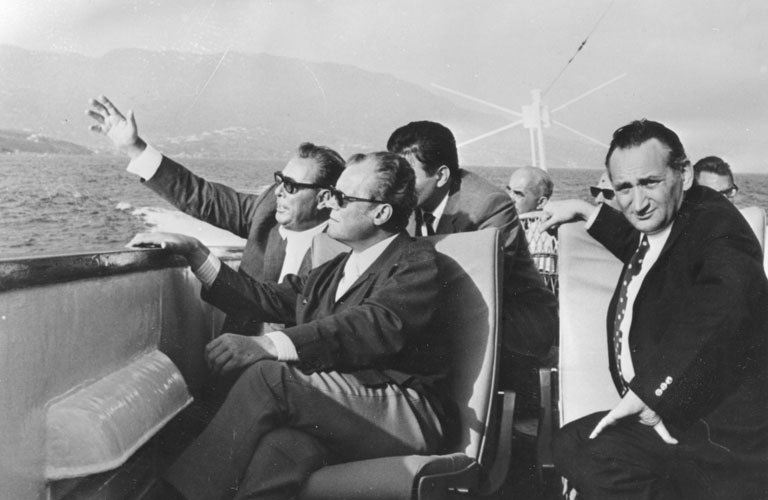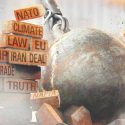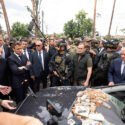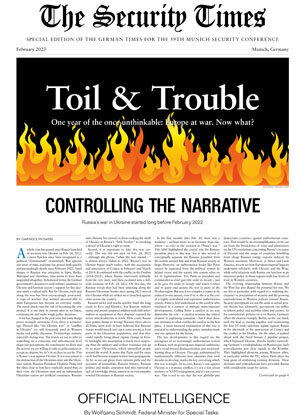Controlling the narrative
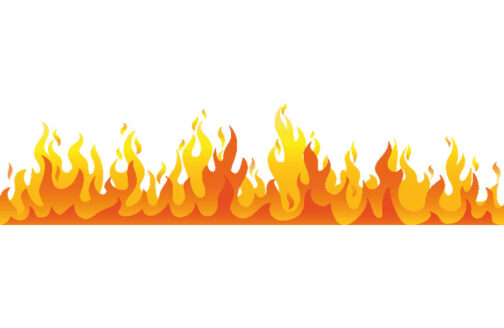 Credit: Shutterstock/ OoddySmile Studio
Credit: Shutterstock/ OoddySmile Studio Russia’s war in Ukraine started long before February 2022
Awhole year has passed since Russia launched its invasion into Ukraine on Feb. 24, 2022, a move that has since been recognized as a political *Zeitenwende* (watershed). War uproots our sense of time, and time has passed both quickly and painstakingly slowly since February 2022. Amid images of Russian war atrocities in Irpin, Bucha, Mariupol and elsewhere, time seems to have been suspended altogether. In historical terms, the German government’s decision to send military assistance to Ukraine and German society’s support for this decision mark a radical shift. But for Ukraine, each step along the way has been excruciatingly protracted. A type of warfare that seemed inconceivable to most Europeans has become an everyday reality. The initial shock runs the risk of becoming the new normal. It is our duty to remain alert as we listen, communicate and make tough policy decisions.
A lot has changed in the past year, but some things prove strangely persistent. First, there is terminology. Phrases like “the Ukraine war” or “conflict in Ukraine” are still frequently used in Western media and public discourse. Terminology matters, especially during war. The words we use to refer to something on a conscious and subconscious level shape our perceptions, the conclusions we draw and the actions we are willing to take as policymakers or accept as citizens. So, let’s be as clear as can be: This is Russia’s war against Ukraine. It is a war aimed at the destruction of the Ukrainian state and the Ukrainian nation. Russian President Vladimir Putin and the elites close to him have explicitly stated that, in their view, the Ukrainian state and an independent Ukrainian nation are artificial constructs. Russian state rhetoric has moved on from evoking the myth of Ukraine as Russia’s “little brother” to invoking a denial of Ukraine’s right to exist.
Second, it is important to date this war correctly. The war did not start on Feb. 24, 2022 – although the phrase “when the war started…” is almost always linked to 2022. Russia’s war in Ukraine began much earlier, with the occupation and annexation of Crimea in February and March of 2014. It continued with the conflict in the Donbas (2014–2022), where Russia intervened militarily from the very start, and then escalated into a full-scale invasion on Feb. 24, 2022. On this day, the Russian troops that had been amassing along the Russian-Ukrainian border since spring 2021 moved into Ukraine while air strikes were launched against cities across the country.
Russian tanks and trucks quickly lined the long roads to Kyiv and Kharkiv, but Russian military tactics and poorly prepared soldiers with little information or equipment at their disposal exposed the severe miscalculations at work. How could Russia have gotten things so wrong? Russian elites, above all Putin, seem truly to have believed that Russian troops would march into open arms among at least parts of the Ukrainian population, and that they could rapidly bring about regime change in Kyiv. In hindsight, this assumption is much more surprising than the military and civilian resistance put up by so many Ukrainians, which astonished people around the world. It seems that Putin and his inner circle had become trapped in their own propaganda. As far as we can glean from opinion polls and the accounts of journalists, Russian history, Russian politics and media saturation had also nurtured a lack of knowledge about, interest in or even empathy toward Ukrainians in Russian society.
In the first months after Feb. 24, there was a tendency – perhaps more so in Germany than elsewhere – to refer to the invasion as “Putin’s war.” This label highlighted the crucial role the Russian president plays in this war, but it also served to conceptually separate the Russian president from the system around him and from Russian society at large. However, an authoritarian leader like Putin cannot be separated from the political system he helped create and the society this system relies on for its legitimization. Yes, Putin as president and commander-in-chief gave the order to invade – just as he gave the order to occupy and annex Crimea and to ignite and sustain the war in parts of the Donbas region. But war is too complex a matter to be reduced to one person, even if he or she is at the core of a highly centralized and repressive authoritarian system. Putin is best understood as the catalyst who retaliated in a context of multiple interconnected developments. Calling Putin a catalyst in no way diminishes his role – a catalyst remains the critical element in explaining causation – but it does draw our attention to what enables the catalyst in the first place. A more nuanced explanation of this war is essential to understanding the policy mistakes made and our options for the future.
The key developments in this regard are the emergence of an increasingly authoritarian system in Russia, with its growing neo-imperial ambitions, and a trend toward democratization and westward-leaning ideas in Ukraine. This gap, underpinned by fundamentally different state identities that took decades to develop, marks the key axis along which this war is fought. At its core, Russia’s war against Ukraine is a systemic conflict; it’s not a war about territory or NATO enlargement, and it’s not a proxy war. This is not to say that the war globally pits democratic countries against authoritarian countries. That would be an oversimplification, as we can see from the breakdown of votes and abstentions on the UN resolutions concerning Russia’s invasion of Ukraine and the range of countries benefiting from cheap Russian energy exports induced by Western sanctions. Moreover, in Africa and Latin America, we can see how European imperial legacies undermine solidarity with Ukraine and the West, while solid relations with Russia can function as an insurance policy in those regions with low levels of trust in Western countries.
The evolving relationship between Russia and the West has also shaped the potential for war. We see this in particular with regard to a widening discrepancy in perceptions of security and the growing contradictions in Western policies toward Russia. Security perceptions are not the same as actual security threats but, ultimately, perceptions can suffice to inform policy and mobilize elites and society. As for contradictory policies vis-à-vis Russia, Germany offers the clearest example. Berlin, on the one hand, took the lead in piecing together and maintaining the first EU-wide sanctions regime against Russia in the aftermath of the annexation of Crimea and the conflict in the Donbas. On the other, it pushed ahead with the Nord Stream 2 pipeline project, which bypassed Ukraine, thereby further entrenching Germany’s overdependence on Russian gas. Such contradictions sent clear signals to the Kremlin. They highlighted divisions among Western allies, in particular within the EU, where Putin plays his long game of reinforcing existing divisions. These divisions and contradictions have provided Russia with considerable scope for action.
Lastly, the years-long escalation in Russia’s war against Ukraine gave both Western powers and Russia the time to adapt mentally and in practical terms to developments. Russia adjusted its economy in order to mitigate the impact of the EU’s initial sanctions. For its part, the West grew too accepting of a new political reality in which the annexation of Crimea, though not recognized by international law, was accepted as the de facto status quo. Similarly, the war in the Donbas could not be resolved on the basis of the Minsk I and II agreements, and Russia’s control over territories in the region was tacitly accepted. Together, these very different developments increased the likelihood of war, and enabled Putin to engage in escalation.
One of the biggest surprises in the last year has been the resistance waged by the Ukrainian military and civilians. The nature of the escalation of Feb. 24, 2022, including the air strikes that hit cities across the country’s territory, along with President Volodymyr Zelensky powerful move to reject the offer of a safe exit and embrace the role of a wartime leader, immediately mobilized nearly all Ukrainians. But longer-term developments, overlooked or underestimated by most Western observers, explain the power of Ukraine’s sustained bottom-up resistance. Ukraine is a country that has gone through several cycles of mass mobilization, in particular the Orange Revolution of 2004 and the Euromaidan in 2013–2014. Protests like these are rare phenomena. Their repeated occurrence, with hundreds of thousands of protesters in the streets, are even more rare. Such events imprint themselves on a society’s DNA and have long-lasting effects that reach beyond a leadership change at the top. They come with a set of experiences, and they shape attitudes and expectations. They create networks among activists but also among ordinary citizens; they strengthen trust in others and become reference points in a country’s collective memory. Framed in inclusive and rights-based terms, Ukraine’s mass mobilizations contributed significantly to a sense of a Ukrainian civic duty and identity. Over the years, including those shaped by the Covid-19 pandemic, opinion polls recorded a remarkable increase in civic engagement in the form of volunteering as well as a rise in pro-democracy views. This stands in stark contrast to developments in many established democracies.
This type of engagement extends beyond the already high density of institutionalized Ukrainian NGOs and presents an important resource for the bottom-up mobilization of society. The country’s ongoing decentralization, which gave local governments new responsibilities and incentives through budgetary powers, and the experience of the Covid-19 pandemic further honed bottom-up initiatives. The exposure to war since 2014 had compelled previous Ukrainian governments to invest in the modernization of the Ukrainian army. Already prior to 2022, Russia had forced the experience of war and displacement upon a sizeable part of the population. These experiences, coupled with an existential threat to their state as a whole, served to prepare Ukrainians for their biggest test yet. Ukrainian society quickly channeled its abilities to self-organize and mobilize into defense and resilience. Tests of societal resilience are difficult to predict before an extreme event takes place, but in the case of Ukraine, the tools needed to act with profound defiance were clearly in place.
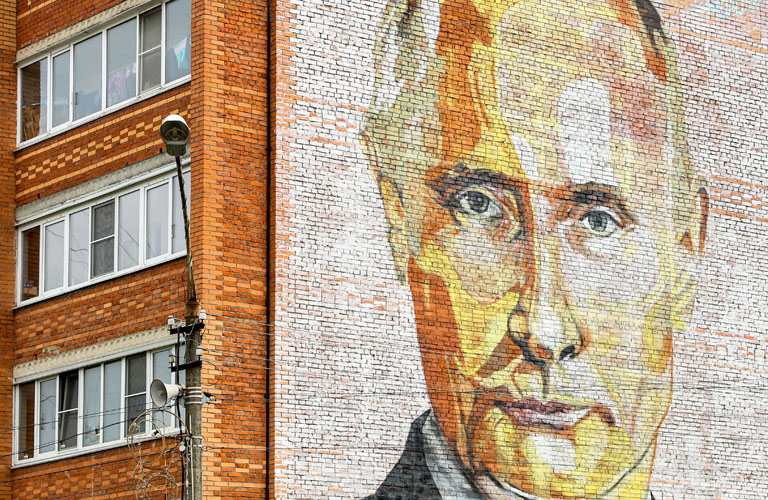
Paint it black: Putin mural in Kashira near Moscow. Credit: picture alliance / REUTERS | Evgenia Novozhenina
Bearing witness to this profound resilience and the all-too apparent weaknesses of Russian tactics were important factors behind the West’s rethinking its commitment to provide Ukraine financial and military support. It is fair to say that without the US government’s quick and substantial military assistance, it’s unlikely that Ukraine would have been able to reconquer territory in the offensives in Kharkiv and Kherson regions in autumn 2022. For NATO’s Central and Eastern European members, providing Ukraine military support is a non-negotiable aspect of their own defense. By contrast, the governments of western NATO countries have tried to assure their populations that they are not and will not be directly involved in this war. In the West, it is increasingly difficult to cultivate a political consensus for each new decision involving stepped-up military support.
The dichotomy between the political systems of Ukraine and Russia is also reflected in the way both countries fight this war. The contrast in their communication strategies could not be starker. Whereas Putin has opted to deliver only the occasional speech, recorded at his old-style office desk, Zelensky has addressed his fellow citizens on a daily basis since Feb. 24, both from the seat of government and from other locations. He frequently communicates via social media, including self-recorded mobile phone messages. He broadcasts potentially dangerous visits to the frontline and recently de-occupied territories. Through virtual meetings, he maintains close links with world leaders and delivers speeches to international institutions, foreign parliaments, universities and other organizations. He continuously presents himself as one Ukrainian citizen of many as well as a member of a larger government team, rather than the leader who makes all the decisions by himself. Large numbers of Ukrainians are actively involved – if they are not fighting in the army or territorial defense units, they are crowdfunding for military equipment or generators and engaging in a wide range of self-help initiatives. By contrast, Russian society has for the most part remained passive, accepting or even supporting the “special military operation” as presented by state media outlets. The Russian army relies on its sheer dominance in terms of equipment and manpower, and the Russian leadership is clearly willing to recruit and use insufficiently trained personnel as it quashes the truth about the war and its costs. The Russian army command structures have remained strictly hierarchical, whereas the Ukrainian army employs more flexible command structures able to adjust more adeptly to the situation at hand. Little can be done to improve the low morale of the Russian soldiers; Ukrainian soldiers know what they are fighting for.
A full year into Russia’s full-scale invasion, an end to this war is not in sight. The Ukrainians are not in a position to negotiate, and the Russian leadership lacks the political will to negotiate. When Putin or his spokesperson talk about the possibility of negotiations, they aim only to confuse Western audiences as they demonize Ukraine and the West for continuing to fight. The sad reality is that any negotiations on a “freezing” of the frontline can now have only one effect: providing Russia time to regroup for a new attack on Ukraine in the near future. This is the main lesson of the ongoing three-stage war begun in 2014.
The fact that Zelensky put a lot on the table for negotiations in the early days and weeks of the current fighting is often forgotten. In return for security guarantees, he offered to return to the line of contact (as of Feb. 23, 2022) in the Donbas, table the issue of Crimea for 15 years and commit to neutrality. However, since the atrocities waged in Irpin, Bucha and Mariupol, Zelensky and Ukrainian society have turned against accepting any territorial concessions. Opinion polls regularly show a consensus on refusing such compromises and the will to reconquer Crimea. Zelensky has adapted his approach to negotiations to the dynamics of the war and can be expected to continue doing so.
However impressive Ukraine’s political and societal resilience has been, this alone will not suffice to ensure its survival; everything depends on what type of military assistance arrives ahead of an expected Russian offensive in spring and on a long-term Western commitment to military and financial assistance. One year on, a political consensus on stepping up assistance remains a fragile one – in both Europe and the US.
Gwendolyn Sasse is Director of the Centre for East European and International Studies (ZOiS) and Einstein Professor for the Comparative Study of Democracy and Authoritarianism at Humboldt University Berlin.

